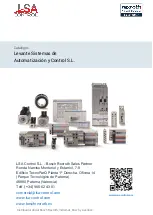
VLT® 5000 Crane
■
Control with Brake Function
The function of the brake is to limit the voltage in
the intermediate circuit when the motor is acting
as a generator. This occurs, for example, when
the load drives the motor and the power enters the
intermediate circuit. The brake is built up in the
form of a chopper circuit with the connection of an
external brake resistor. Placing the brake resistor
externally offers the following advantages:
-
The brake resistor can be selected on the basis
of the application in question.
-
The brake energy is dissipated outside the control
panel, ie. where the energy can be utilized.
-
The electronics of the frequency converter will not
be overheated if the brake resistor is overloaded.
The brake is protected against short-circuiting of the
brake resistor, and the brake transistor is monitored to
ensure that short-circuiting of the transistor is detected.
By using a relay/digital output, the latter can be used
for protecting the brake resistor against overloading in
connection with a fault in the frequency converter.
In addition, the brake makes it possible to read out the
momentary power and the mean power for the latest
120 seconds, as well as to monitor that the power
energizing does not exceed a monitoring limit selected
via parameter 402. In parameter 403 select the function
to be carried out when the power transmitted to the
brake resistor exceeds the limit set in parameter 402.
NB!:
Monitoring of the brake power is not a
safety function; a thermal switch is required
for that purpose. The brake resistor circuit
is not earth leakage protected.
■
Selection of Brake Resistor
In order to select the right brake resistor, the
application must be known through-and-through,
i.e. it must be known how often to brake and by
how much power braking is effected.
The resistor ED, which is often used by motor suppliers
when stating the permissible load, is an indication of
the duty cycle at which the resistor is working.
The resistor ED is calculated as follows:
in which t2-t1 = cycle time in seconds and tb is the
braking time in seconds (of the cycle time).
The maximum permissible load on the brake resistor
is stated as a peak power at a given ED. That is
why the peak power for the brake resistor and the
resistor value must be determined.
The following example and formula apply to VLT
5000 and VLT 5000 Crane. The peak power can
be calculated on the basis of the highest brake
resistance required for braking:
P
PEAK
= P
MOTOR
x M
BR(%)
x
η
MOTOR
x
η
VLT
[W]
where M
BR(%)
is expressed as a percentage
of the rated torque.
The brake resistance is calculated as follows:
As can be seen, the brake resistance depends on
the intermediate circuit voltage (UDC).
With VLT 5000 Crane frequency converters that
have a mains voltage of 3 x400-500 Volts, the
brake will be active at 822 Volts (UDC).
NB!:
Remember to check whether the brake resistor
used is able to cope with a voltage of 850 Volts
- unless Danfoss brake resistors are used.
R
REC
is the brake resistance recommended by
Danfoss, i.e. one that guarantees the user that
the frequency converter is able to brake at the
highest braking torque (M
br
) of 160%.
η
motor
is typically at 0.90, while
η
VLT
is typically
at 0.98. For 500 V frequency converters, R
REC
at
160% braking torque can be written as:
NB!:
The max. brake resistance selected should
have an ohmic value max. 10% lower than
that recommended by Danfoss. If a brake
resistor with a higher ohmic value is selected, the
160% braking torque will not be achieved and
there is a risk that the VLT 5000 Crane will cut out
for safety reasons. For further information, please
consult Brake Instructions MI.50.Dx.xx.
MG.50.N4.02 - VLT is a registered Danfoss trademark
116







































